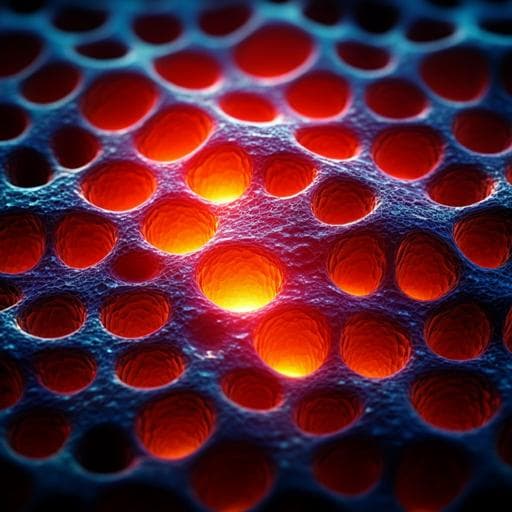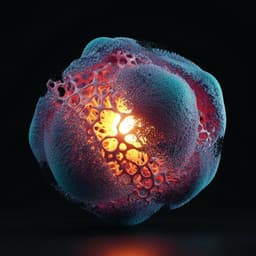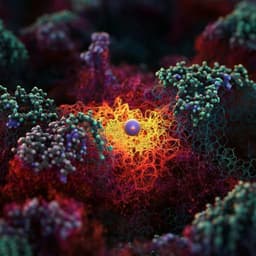
Engineering and Technology
Long-life lithium-sulfur batteries with high areal capacity based on coaxial CNTs@TiN-TiO2 sponge
H. Zhang, L. K. Ono, et al.
This groundbreaking research by Hui Zhang, Luis K. Ono, Guoqing Tong, Yuqiang Liu, and Yabing Qi presents the development of a coaxial CNTs@TiN-TiO2 sponge as an advanced catalyst for lithium-sulfur batteries, showcasing remarkable capacity retention and efficiency in lithium polysulfide conversion.
~3 min • Beginner • English
Introduction
Lithium-sulfur (Li-S) batteries offer a high theoretical energy density (2600 Wh kg−1), but their practical use is hindered by the shuttle effect of dissolved lithium polysulfides, which leads to rapid capacity fading and poor cycle life. Prior strategies using porous carbons and polar compounds can physically and chemically suppress shuttling but remain insufficient, particularly at high sulfur loadings. A more effective approach is to catalytically accelerate the conversion of polysulfides to Li2S2/Li2S, thereby reducing their accumulation. An ideal catalyst must provide high electrical conductivity, adequate polysulfide adsorption, and strong catalytic activity; however, single materials rarely meet all three criteria. TiO2 offers strong adsorption but poor conductivity, while TiN provides good conductivity but weak adsorption. The authors propose a rationally designed TiN–TiO2 heterostructure integrated onto a 3D CNT sponge via atomic layer deposition (ALD) and post-annealing to create a continuous interface that combines strong adsorption and rapid catalysis with efficient electron pathways. This design aims to enhance polysulfide conversion kinetics, mitigate shuttling, support high sulfur loadings, and deliver high areal capacities with long cycle life.
Literature Review
- Metal oxides such as TiO2 strongly adsorb polysulfides but suffer from low electrical conductivity, limiting further electrochemical reactions of trapped species.
- Metal nitrides such as TiN exhibit high electrical conductivity but weak polysulfide affinity, limiting adsorption.
- Heterostructures combining complementary functions have shown promise. Examples include:
- TiN–TiO2 interlayer-based Li-S systems achieving ~73% capacity retention over 2000 cycles at 1C, attributed to synergistic adsorption (TiO2) and catalysis (TiN).
- WS2–WO3 heterostructures that first trap polysulfides with WO3 and then catalyze conversion on WS2, delivering 86.1% retention after 300 cycles at 0.5C.
- Conventional synthesis routes for such heterostructures (e.g., solvothermal reactions with high-temperature post-treatments) are complex and make precise control of composition and distribution challenging, which is critical for catalytic performance. This motivates the use of ALD for atomic-scale, conformal, and controllable coating of heterostructures.
Methodology
- Substrate preparation: A three-dimensional (3D) freestanding carbon nanotube (CNT) sponge was synthesized by CVD using ferrocene and 1,2-dichlorobenzene. The sponge was nitric-acid treated (70% HNO3, 120 °C, 12 h), water-rinsed to neutral pH, freeze-dried, and functionalized with carboxyl groups to aid hybridization with polar materials.
- ALD fabrication of heterostructures:
- TiN deposition: CNTs were coated with TiN by ALD at 150 °C (Savannah S200) using tetrakis(dimethylamido)titanium (TDMAT) with NH3, achieving target thicknesses of 5, 10, and 20 nm (samples denoted CNTs@TiN-5/10/20). Thickness was controlled by ALD cycles; morphology was verified by TEM.
- TiO2 deposition: On the optimized CNTs@TiN-10, a TiO2 layer (2, 5, or 10 nm) was deposited by ALD at 150 °C using TDMAT and H2O, yielding CNTs@TiN@TiO2 with controlled TiO2 thickness.
- Post-annealing: To improve crystallinity and form a mixed, continuous TiN–TiO2 layer, CNTs@TiN@TiO2 were annealed in flowing N2 (200 sccm) to 650 °C at 10 °C min−1. The annealed products are denoted CNTs@TiN-TiO2-2/5/10 corresponding to the pre-anneal TiO2 thickness.
- Structural and compositional characterization: SEM, TEM (including HRTEM and EDX mapping), XRD (Cu source), XPS (Al Kα), electrical conductivity (four-probe), and N2 sorption (BET surface area and pore size/volume) were performed. TEM/HRTEM confirmed a continuous, atomically matched TiN–TiO2 interface; XRD showed no new crystalline phases post-anneal; BET showed increasing surface area/mesopore volume with higher TiO2 content.
- Polysulfide adsorption tests: Visual adsorption by immersing CNTs@TiN-TiO2-2/5/10 in 0.005 M Li2S6 overnight in Ar glovebox; XPS before/after adsorption to probe chemical interactions (Ti 2p binding energy shifts; emergence of Li3N and N–S features in N 1s).
- Catalytic activity and kinetics:
- Symmetric cells (identical material as both electrodes) assembled with electrolyte containing Li2S6 to isolate cathode catalyst kinetics (excluding Li metal anode effects). Cyclic voltammetry (2 mV s−1) conducted; absence of peaks without Li2S6 confirmed the active role of polysulfides.
- Li2S precipitation kinetics: Coin cells with Li foil anode and Celgard 2500 separator; Li2S6 formation via galvanostatic discharge to 2.06 V then potentiostatic hold at 2.05 V until current <1×10−5 mA; precipitation current and capacity extracted by fitting discharge curves to segments corresponding to Li2S2/Li2S reduction and Li2S precipitation.
- Li–S cell assembly and electrochemical testing:
- Freestanding cathodes: CNTs@TiN-TiO2-2/5/10 sponges loaded with Li2S/electrolyte as active material (average areal masses 3.7, 3.3, and 3.1 mg cm−2, respectively). Sulfur loading up to 15 mg cm−2; electrolyte-to-sulfur mass ratio 10 μL mg−1.
- Electrolyte: 1,3-dioxolane:dimethoxyethane (1:1) with 1 M LiTFSI and 1 wt% LiNO3; separators: Celgard 2400 PP; Li metal anode; CR2032 coin cells.
- Electrochemical protocols: Galvanostatic cycling 1.5–3.0 V at 0.1–5 C; CV at 0.1 mV s−1; EIS (5 mV AC, 100 kHz–0.01 Hz). Areal capacity Ca = Cs × Ma; device gravimetric energy density E = f × Cs × V (V = 2.2 V).
Key Findings
- Optimized heterostructure: A coaxial CNT sponge with a TiN–TiO2 heterostructure formed by ALD and post-annealing performs best when TiN is ~10 nm and TiO2 is ~5 nm (CNTs@TiN-TiO2-5). HRTEM shows a continuous, well-matched interface between TiN (0.244 nm, (111)) and TiO2 (0.324 nm, (110)).
- Adsorption and chemical interaction:
- Visual tests show adsorption ability: TiO2 > TiN > CNTs; increasing TiO2 content increases polysulfide adsorption; 5 nm TiO2 renders Li2S6 solution nearly transparent.
- XPS indicates chemical bonding after Li2S6 exposure: Ti 2p peaks shift from 465/459.4 eV to 464.6/458.9 eV; N 1s shows Li3N and N–S features, evidencing strong interaction with polysulfides.
- Catalytic kinetics:
- Symmetric-cell CV with Li2S6 exhibits narrower peak separations and higher currents for CNTs@TiN-TiO2-5, indicating faster redox kinetics than -2 and -10 samples.
- Li2S precipitation capacity: CNTs@TiN-TiO2-5 achieves ~328 mAh g−1 vs ~250 mAh g−1 (-2) and ~153 mAh g−1 (-10), reflecting superior catalysis of final Li2S formation.
- Electrochemical performance (Li–S cells):
- CV (0.1 mV s−1): CNTs@TiN-TiO2-5 shows sharpest peaks and smallest polarization among the three hybrids.
- Rate capability: Specific capacities for CNTs@TiN-TiO2-5 are ~1350, 1250, 1000, 900, and 800 mAh g−1 at 0.1, 0.5, 1, 2, and 5 C, respectively; lower for -2 and -10.
- Charge transfer: EIS shows the smallest semicircle (lowest charge-transfer resistance) for CNTs@TiN-TiO2-5; CNTs@TiN-TiO2-10 exhibits two semicircles and much higher resistance.
- Cycling: At 0.2 C, initial specific capacities are 1271 (-2), 1431 (-5), and 1125 mAh g−1 (-10); after 100 cycles, -5 retains ~1330 mAh g−1 vs 1021 (-2) and 773 mAh g−1 (-10). At 1 C and 2 C, capacity fading rates are ~0.0056%/cycle (over 220 cycles) and ~0.031%/cycle (over 500 cycles), respectively. The abstract reports a high specific capacity of 1289 mAh g−1 at 1C and 85% capacity retention after 500 cycles at 2 C.
- Areal performance: With sulfur loading up to 15 mg cm−2, the areal capacity reaches up to 21.5 mAh cm−2 at 0.2 C (and 19.3 and 12.2 mAh cm−2 at 1 C and 2 C). The device-level gravimetric energy density is ~269.05 Wh kg−1 at 0.2 C.
- Structure–performance insights: Excessive TiO2 (10 nm) leads to irregular boundaries, increased resistance, hindered polysulfide diffusion, and degraded performance; too-thin TiN (5 nm) forms loose/unstable coatings with poorer long-term stability. A continuous mixed TiN–TiO2 layer after annealing enables TiO2-assisted adsorption and TiN-catalyzed conversion, synergizing with the conductive, porous 3D CNT network for high loading and utilization.
Discussion
The study demonstrates that a rationally engineered TiN–TiO2 heterostructure on a 3D CNT sponge resolves the trade-offs between adsorption strength and electrical conductivity that limit single-component hosts. The continuous, atomically matched interface formed via ALD and annealing enables a two-step conversion pathway: TiO2 first strongly adsorbs lithium polysulfides, then the adsorbed species readily diffuse across the seamless interface to conductive TiN for rapid catalytic conversion to Li2S2/Li2S. This architecture accelerates both solution-phase polysulfide reactions and the intrinsically sluggish solid–solid Li2S2→Li2S transformation, reducing shuttle-induced losses and polarization. The CNT sponge provides interconnected electron pathways and high porosity for uniform active-material infiltration and high sulfur loadings, delivering high areal capacities. Electrochemical signatures (narrow CV peak separations, low charge-transfer resistance, strong Li2S precipitation kinetics) corroborate the improved reaction kinetics. The optimized coating thicknesses are critical: insufficient coverage compromises stability/adsorption, while excessive or dense oxide layers hinder diffusion and electron transport. Overall, the findings validate the hypothesis that a conformal, continuous heterostructure with balanced adsorption and catalytic sites can markedly enhance Li–S battery performance at practical areal loadings.
Conclusion
A 3D coaxial CNT sponge uniformly coated with a TiN–TiO2 heterostructure was fabricated via ALD and post-annealing. By optimizing TiN (~10 nm) and TiO2 (~5 nm) thicknesses to form a continuous, well-matched interface, the host material achieves strong polysulfide adsorption, efficient catalytic conversion, and excellent charge transport. Li–S cells deliver high specific and areal capacities (up to 21.5 mAh cm−2 at 0.2 C), high rate performance, and long cycling stability with low fading rates and 85% capacity retention after 500 cycles at 2 C. The approach provides a controllable pathway to tune heterostructure composition/distribution and can be extended to other coaxial or layer-by-layer catalysts for energy storage and catalysis.
Potential future work includes: applying this heterostructure strategy to other material combinations; scaling ALD/annealing to larger-format electrodes; integrating with lean-electrolyte and practical cell designs; and investigating long-term stability and interfacial chemistry under varied operating conditions.
Limitations
- The optimal performance depends sensitively on precise ALD-controlled thicknesses and a post-annealing step; as-deposited films exhibit low crystallinity and dense TiO2 layers can impede diffusion/electron transport.
- Excess TiO2 (e.g., nominal 10 nm) leads to irregular boundaries and increased resistance, degrading catalytic activity and charge transport.
- Symmetric-cell tests for catalytic kinetics intentionally exclude lithium metal anode effects; thus, full-cell behavior with lithium anodes is not fully captured by those measurements.
- Results are demonstrated in coin cells with a specific ether-based electrolyte and an electrolyte-to-sulfur ratio of 10 μL mg−1; translation to pouch cells and leaner electrolyte conditions requires further validation.
Related Publications
Explore these studies to deepen your understanding of the subject.







